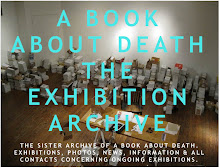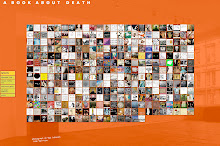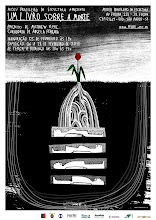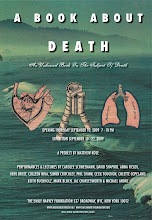Subscribe to:
Post Comments (Atom)
skip to main |
skip to sidebar

Gunned Down & Murdered In Tehran June 20, 2009. A Book About Death Supports A Free Iran.
A BOOK ABOUT DEATH : ARTISTS CONTRIBUTE 500 POST CARDS EACH TO CREATE AN UNBOUND BOOK ABOUT DEATH. EXHIBITION AT THE EMILY HARVEY FOUNDATION GALLERY IN NEW YORK CITY. OPENING: THURSDAY 10 SEPTEMBER 2009. EXHIBITION: 10 - 22 SEPTEMBER 2009. TUES - SAT 1 PM - 7PM.
About Me
PRESS ARTICLES
Viv Maudlin Film
GRACE GRAUPE-PILLARD FILM
A Book About Death from Grace Graupe Pillard on Vimeo.
Jac Charlesworth Film
Honey Millman Film
IMPORTANT LINKS
LIVE WEB CAST 6 PM SEPT 10, 2009
A BOOK ABOUT DEATH
A BOOK ABOUT DEATH : ARTISTS CONTRIBUTE 500 POST CARDS EACH TO CREATE AN UNBOUND BOOK ABOUT DEATH. AN HOMAGE TO RAY JOHNSON, A CELEBRATION OF EMILY HARVEY, A GLOBAL EXPLORATION OF DEATH.
NO LIMIT TO THE NUMBER OF ARTISTS CONTRIBUTING. CDs, DVDs & OBJECTS ACCEPTED - SEND 500. DEADLINE: SEPTEMBER 5!
EXHIBITION AT THE EMILY HARVEY FOUNDATION GALLERY IN NEW YORK CITY. OPENING: THURSDAY 10 SEPTEMBER 2009. EXHIBITION: 10 - 22 SEPTEMBER 2009. OPENING : 7:30 - 11 PM.
PROJECT SPONSORS
NEDA SOLTAN

Gunned Down & Murdered In Tehran June 20, 2009. A Book About Death Supports A Free Iran.
IMPORTANT: SENDING .JPG IMAGES FOR BLOG & SITE
IMPORTANT: ONCE YOU'VE COMMITTED IMAGES TO PRINT, SEND YOUR IMAGES TO MATTHEW.ROSE.PARIS@GMAIL.COM IN JPG FORMAT, SEND LARGE IMAGES (but not heavy in the megabyte sense). APPROX 900 x 600 PIXELS – OR 200K – FOR EACH IMAGE IS BEST. THIS PERMITS FAST LOADING ON THIS BLOG AND WEB SITE.
NOTE: YOU ARE NOT OBLIGED TO PUT IN THE VENUE INFO, ONLY THE TEXT : A BOOK ABOUT DEATH, ANY SIZE, ANY STYLE, ANY LANGUAGE. YOU ARE FREE TO CREATE WHATEVER YOU WISH. A POST CARD IS A PAPER MACHINE.
NOTE: YOU ARE NOT OBLIGED TO PUT IN THE VENUE INFO, ONLY THE TEXT : A BOOK ABOUT DEATH, ANY SIZE, ANY STYLE, ANY LANGUAGE. YOU ARE FREE TO CREATE WHATEVER YOU WISH. A POST CARD IS A PAPER MACHINE.
Followers
SUBMIT YOUR WORK TODAY
CLICK HERE FOR ALL INFO ON SUBMITTING YOUR WORK FOR THE OPEN ARTIST CALL : A BOOK ABOUT DEATH. PLEASE NOTE: DEADLINE SEPTEMBER 5.
SPONSOR THE EXHIBITION
We are looking for a dozen sponsors for the opening. What we need: 12 - 24 bottles of wine each. We will list you here and in the printed program. Get in touch. Doesn't cost much and you'll be famous and we'll love you. CLICK HERE : TO E-MAIL MATTHEW ROSE
SPONSOR THE EXHIBITION
We are looking for a dozen sponsors for the opening. What we need: 12 - 24 bottles of wine each. We will list you here and in the printed program. Get in touch. Doesn't cost much and you'll be famous and we'll love you. CLICK HERE : TO E-MAIL MATTHEW ROSE
WHERE TO SEND THE 500 POSTCARDS:
Send Cards Here (Exact Address):
The Emily Harvey Foundation
537 Broadway #2
New York City, New York 10012 USA
Tel +1 212 925 7651
The Emily Harvey Foundation
537 Broadway #2
New York City, New York 10012 USA
Tel +1 212 925 7651
PRINTING YOUR CARDS
You can produce your own cards, print them in your country, or use these:
1. GOT PRINT (US)
2. OVERNIGHT PRINTS (US)
3. UPRINTING (US)
FOR OVERNIGHT, TYPE IN CODE FOR DISCOUNT: POSTCARDSALE
1. GOT PRINT (US)
2. OVERNIGHT PRINTS (US)
3. UPRINTING (US)
FOR OVERNIGHT, TYPE IN CODE FOR DISCOUNT: POSTCARDSALE
Blog Archive
SPREAD THE WORD ABOUT A BOOK ABOUT DEATH
Twitter? Send the Artist Call For A Book About Death Out On Twitter. Blog? Write A Post. E - Mail the URL To Artist Friends. Press? Contact Matthew Rose Directly.








![THE PROGRAM [DOWNLOAD PDF]](http://1.bp.blogspot.com/_SAUcA31atjA/SqSHZfoppEI/AAAAAAAADUM/ehptv2xIp9Q/S220/PROGRAM+FLYER_DIVING+POSTER.1.jpg)


















2 comments:
Your artwork has been received by the Emily Harvey gallery.
There is an unseen circulatory system that connects people to each other and to communities. When death comes to an elderly family member or beloved pet, other people in the system reach out to help and console. It is different when death comes through violence or disease as an unjust surprise to an unsuspecting victim. The life flow of the system withdraws and shuts down. Every act of kindness towards the survivors is experienced as an extraordinary gesture. The aftermath of the event is handled by professional death managers, IE., grief counselors, prescription writing doctors, psychologists, and trauma specialists who talk about finding "the new normal". Faith communities are expected to be the providers of "meaning" for the deceased, survivors, and greater society. Death isn't contagious. Every living creature has a birth date and a death date. Yet, death separates and silences us. We ignore it, deny it, spiritualize it, and somehow think that it "happens to other people and won't happen to us if we only associate with the living". We don't know how to "be around" grieving survivors. With concern, we ask them if "they are seeing someone" and when they think they will be "ready to move on". I believe that the project, "A Book About Death" serves as an existential living document that pumps the life flow back into areas of the circulatory system which have been severed due to silence. I personally don't think that artists are avoiding subject matter, such as 9/11, because it is taboo, but rather, are including those who are living in the aftermath of violence such as 9/11, the murder of Neda Soltan, and all other unjust surprise deaths that touch the lives of countless people, in the circulatory system of the intended audience for "A Book About Death."
Post a Comment